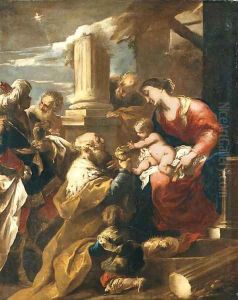Valerio Castello Genoa Paintings
Valerio Castello was an Italian Baroque painter of the Genoese School, born in Genoa in 1624. He is recognized for his vibrant and expressive style, which was influenced by the great masters of his time. Castello's father, Bernardo Castello, was also a painter, and it was under his guidance that Valerio began his artistic education. His father's influence was crucial in shaping Valerio's early style, which was characterized by a vivid color palette and dynamic compositions.
Valerio Castello's work was deeply influenced by the artistic developments occurring in Italy during the 17th century. He was particularly affected by the works of Peter Paul Rubens and Anthony van Dyck, whose paintings he would have encountered in Genoa, a city that was a significant artistic center at the time. These Flemish painters' dramatic use of light and shadow, as well as their dynamic figuration, left an indelible mark on Castello's own style. Furthermore, he was inspired by the Roman Baroque movement, especially by the works of artists such as Pietro da Cortona and Giovanni Lanfranco.
Despite his relatively short life, Castello's output was prolific and diverse, ranging from large altarpieces to smaller cabinet paintings. His subjects included religious scenes, mythological narratives, and allegories, executed with a flair that made them popular among collectors and patrons. Among his notable works are 'The Martyrdom of Saint Lawrence', painted for the church of San Lorenzo in Genoa, and 'The Rape of the Sabines', showcasing his ability to depict movement and emotion vividly.
Valerio Castello's career was cut short when he died of the plague in 1659, at the age of 35. His untimely death deprived Genoa of one of its most promising artists. However, his legacy lived on through his works, which continued to influence the Genoese School and the development of Baroque painting in the region. Today, Castello is remembered as one of the key figures in the Genoese artistic milieu of the 17th century, and his paintings can be found in museums and collections around the world, celebrated for their energy, color, and expressive force.
